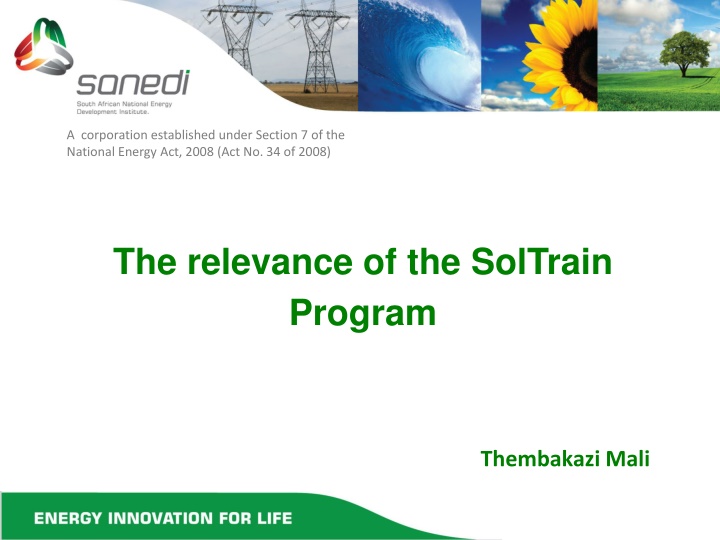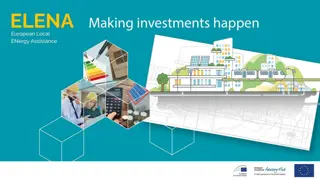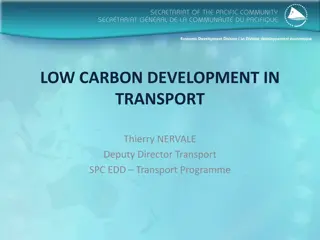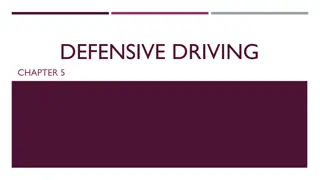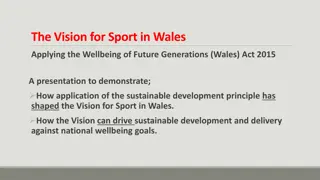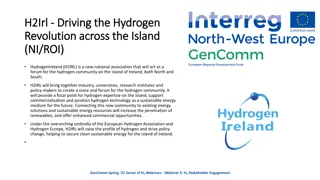National Energy Act and SANEDI: Driving Sustainable Energy Future
The National Energy Act of 2008 established SANEDI to lead energy research, development, and efficiency initiatives in South Africa. The Act outlines strategic outcome programs focusing on corporate governance, applied energy research, renewables, and energy efficiency. SANEDI's mission is to support the national energy mandate towards a low-carbon future through innovative projects like the SolTrain Program in Mali. Collaboration with GIZ and international partners further enhances South Africa's renewable energy capabilities and technical expertise.
Download Presentation

Please find below an Image/Link to download the presentation.
The content on the website is provided AS IS for your information and personal use only. It may not be sold, licensed, or shared on other websites without obtaining consent from the author.If you encounter any issues during the download, it is possible that the publisher has removed the file from their server.
You are allowed to download the files provided on this website for personal or commercial use, subject to the condition that they are used lawfully. All files are the property of their respective owners.
The content on the website is provided AS IS for your information and personal use only. It may not be sold, licensed, or shared on other websites without obtaining consent from the author.
E N D
Presentation Transcript
A corporation established under Section 7 of the National Energy Act, 2008 (Act No. 34 of 2008) The relevance of the SolTrain Program Thembakazi Mali
About SANEDI The National Energy Act, No. 34 of 2008 established the South African National Energy Development Institute (SANEDI) by transferring all the personnel, assets and liabilities of the South African National Energy Research Institute (SANERI), also a wholly owned subsidiary of CEF, and the National Energy Efficiency Agency (NEEA), to SANEDI. The National Energy Act, 2008 (Act No. 34 of 2008), Section 7 (2) provides for SANEDItodirect, monitor and conduct energy research and development as well as undertake measures topromote energy efficiency throughout the economy. The overarching purpose of SANEDI is to assist the Department of Energy in fulfilling its energy mandate andtransition towards asustainable, low carbon energy future.
South Africas Renewable Energy Policies National Policies and Strategies National Energy Research, Development and Innovation Strategy (developed by DME, DST and stakeholders) National target Renewable Energy Production of 10 000 GWh by 2013 (under Review) Biofuels Industrial Strategy 2007 2% penetration by 2013 EE target - energy demand reduction of 12% by 2015 SWH National Target 1 000 000 by 2014 Ten-Year Innovation Plan for South Africa (5 Grand Challenges Energy Security, Farmer to Pharma) Long Term Mitigation Strategy (scenarios to mitigate greenhouse gas emission) IRP 2010 (42% by 2030) National Energy Act (No 34 of 2008)
Strategic outcomes /programmes STRATEGIC OUTCOMES PROGRAMMES All/Crosscutting 1. Corporate governance and administration Enable well informed and high confidence energy planning, decision- making and support policy* development 2. Applied energy research and demonstration including sub-programmes for: Advanced fossil fuels including Carbon Capture and Storage Renewables Smart Grids Support accelerated transformation to a less energy and carbon intensive economy Green Transport Working for Energy Data and Knowledge Management Foster a culture of energy efficiency and more rational energy use 3. Energy efficiency programme
Renewables Renewable Energy Centre of Research & Development (RECORD) in collaboration with GIZ and supporting technician training at CPUT and Technology Platforms Projects in progress: Wind Atlas for South Africa (WASA) consortium partners include DUT, Denmark, CSIR, SAWS and UCT Support to Solar industry (met stations as part of larger SA Solar Atlas, SAURAN) International collaboration (IEA Implementation Agreements and NCP for H2020)
Progress on SWH Installation A number of key developments have taken place and new initiatives are being undertaken CEF 500 Project increased awareness, introduced standards and quantified savings Eskom Subsidy Program to install 925 000 SWH by offering an incentive in the form of a rebate payable to homeowners. The rebate amount is based on thermal efficiency as tested by the SABS. (Program stopped and handed to DOE) Western Cape Provincial Government has installed 1 000 in rural homes as part of a pilot project City of Cape Town - large-scale installation in a low income area, Kuyasa project involves installation of SWH, ceiling insulation and compact fluorescent lighting and has been registered as SA s first project under the CDM >10% city owned homes running on SWH. Has created a by-law through the building plans approval to have all new residential and commercial buildings equipped with SWH 6
Progress on SWH Installation Nelson Mandela Bay Metro targeting 1 220 (300) installations, offering homeowners low-interest loans with flexible repayment terms Ekurhuleni - >100 000 units, 72 months payment, ownership thereafter DOE Target of 1 000 000 by 2014 Target missed To ensure a smooth transition into the new incentive scheme, DOE and NERSA are in consultation. The approach as well as timelines for its implementation still outstanding. 7
SWH INSTALLATIONS: 10 JANUARY 2014 PROVINCE QUANTITY % LIMPOPO 4,512 1% NORTH WEST MPUMALANGA NORTHERN CAPE FREE STATE 11,359 15,228 16,534 33,576 3% 4% 4% 8% WESTERN CAPE 56,071 14% EASTERN CAPE KWAZULU-NATAL GAUTENG 56,957 71,149 134,660 14% 18% 34% NATIONAL AVERAGE 44,450 11% TOTAL 400,046 100%
Barriers to uptake Supply chain low local SWH manufacture, reliance on imports (quality) Cost of equipment systems are relatively expensive Installation capacity - insufficient number of qualified installers Regulation and testing SABS overloaded due to sudden influx of units for testing Awareness consumers do not fully appreciate the benefits and have misconceptions that no hot water when is raining Vandalism shortage of copper, SWH components containing copper such as pressure values attract thieves 9
Recommendations to increase uptake Policy, targets, regulation and legislative support Incentives needed to stimulate uptake, mandatory inclusion in buildings (gas heating, heat pumps) Appliance labeling Financing mechanisms Establish RE financial institutions or have innovative financing models Introduction of tax incentives to consumers Quality assurance and market assurance Adoption of component testing International standards adapted to SA conditions and testing done not only at SABS but at outsourced to accredited testing facilities Training skills increased to meet demand 1 0
SOLTRAIN Southern African Solar Thermal Training and Demonstration Initiative SOLTRAIN is currently facilitating knowledge transfer and promoting the adoption of this technology within the South Africa and some neighbouring countries (Namibia, Lesotho, Botswana and Zimbabwe). One of the most important objectives is building up training capacities in the participating countries and the improvement of the quality, performance and lifetime of solar thermal systems. 1 1
Relevance Technology Roadmap: Plan for better roll out Value Chain identification Policy recommendations Industry Support Skills Development Awareness raising Reliable data SolTrain supports our recommendations
